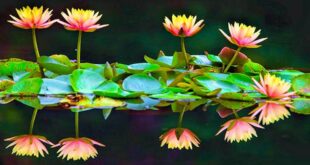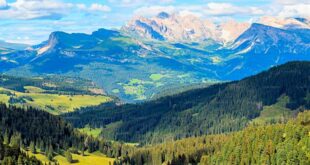What a bundle of contradictions we humans can seem to be! We want to belong, to be like everyone else, and yet at the same time we desire to be acknowledged and to express our individuality within the larger group. The wondrous thing is that together we form the kingdom in nature which finds it possible to identify both with the individual part we think we are and with the Whole expressing through many parts. We live this duality reconciled within us. We walk the tightrope between the parts and the whole and so undertake the journey of unification leading to the realisation of the synthesis of all Life. This is reflected in William Blake’s poem, Auguries of Innocence, which begins with these words, oft-quoted and eternally evocative:
To see a world in a grain of sand
And a heaven in a wild flower,
Hold infinity in the palm of your hand,
And eternity in an hour.
If we think in terms of “wholes” we can see more clearly the currents of realisation sweeping through human consciousness on a new wave – a tsunami even. And beneath this revelatory tide, greater forces become apparent. We are opening new eyes, a new vision and a new dynamic of livingness that sees through the superficial expediencies of unenlightened rulership with all its oppressive institutions, coercive practices, elitism and secrecy. Peoples around the world are resisting suppression, censorship and disenfranchisement through mass demonstrations and even violent conflict such as we see reported in the Ukraine, Egypt, Thailand, Syria.
We realise that our living depends on the all-inclusive, interconnected ecology which sustains us all
Investigations and Royal Commissions into past abuses, previously protected by institutions, are using new eyes and a new depth of vision to penetrate to the truth and bring greater compassion for victims and a deeper understanding of the part played by the social forces of the time. Public scrutiny of the proceedings enables community-wide realisation and is a powerful impetus for progress. A clearer light shines on human values as the greater whole, through time and space, becomes more accurately reflected in the life actions, reactions and events of immediate, local, “ordinary” life. We are approaching that point where the universal is seen reflected in the particular and the particular is understood more clearly within the universal.
Our world is becoming local. We are just as instantaneously in touch with someone on the other side of the planet as we are with the person sitting next to us. While we may descry the addictive use of “Smart Phones” inhibiting conversation and exchange with those present, we are in the process of finding our point of balance at the heart of things where the whole is ever present in the part and the part is ever aware of its greater Self within the Whole. That time will come when we become:
…aware of the two extremes of the divine expression: the sense of individual identity and the sense of universality. These are fused and blended in the ONE… In the state of being which we call the monadic, no difference is recognised between these two because …it is realised that there is no identity apart from universality and no appreciation of the universal apart from the individual realisation, and this realisation of identification with both the part and the whole finds its point of tension in the will-to-be, which is qualified by the will-to-good and developed (from the consciousness angle) by the will-to-know.” [The Rays and the Initiations page 106]
Vision can reveal or hide what is real and true
The eyes gather visual information by constantly scanning the environment. But visual data from ‘out there’, gathered by sight, is not the end of the story. At least part, and perhaps much of what we see is changed, interpreted, or conceptualized in ways that depend on a person’s training, mind-set, and past experiences. We tend to see what we expect to see or what we decide we have seen. This expectation or decision, however, often is not a conscious process. Instead, the brain frequently does the expecting and deciding, without our conscious awareness, and then alters or rearranges – or even simply disregards – the raw data of vision that hits the retina. Learning perception through drawing seems to change this process and to allow a different, more direct kind of seeing. The brain’s editing is somehow put on hold, thereby permitting one to see more realistically. …This experience is often moving and deeply affecting. My students’ most frequent comments after learning to draw are: ‘Life seems so much richer now’ and ‘I didn’t realize how much there is to see and how beautiful things are’.”
How beautifully does Rabindranath Tagore express the wonderment and sense of connection that such realisations confer:
The same stream of life that runs through my veins night and day
runs through the world and dances in rhythmic measures.It is the same life that shoots in joy through the dust of the earth
in numberless blades of grass
and breaks into tumultuous waves of leaves and flowers.It is the same life that is rocked in the ocean-cradle of birth
and of death, in ebb and in flow.I feel my limbs are made glorious by the touch of this world of life.
And my pride is from the life-throb of ages dancing in my blood this moment.”
We are a conscious part of the creation in which we live, move and have our being, and so can be very powerful in effect – more than we may yet realise, individually or collectively. But perhaps, as our inherent and potent creative nature dawns on us, the coming civilisation may emerge through creative Art just as the present one has been progressed and shaped by Science. Perhaps it is through the Art of living, seeing and visualisation that we will co-create the New World. The Tibetan explains the importance of:
…the development of the Art of Visualisation. Through visualisation, three expressions of the human consciousness will become possible:
1. … the new vision—an outcome of the development of the sense of vision.
2. Groups, large wholes and major syntheses will also be visualised, and this will lead to a definite expansion of consciousness. Thus the sense of synthesis will be unfolded.
3. All creative art will be fostered by this training, and the new art of the future in all departments of creativity will be rapidly developed as the training proceeds. The unfoldment of the sense of vision and of the sense of synthesis, through visualisation, will lead to a sense of livingness in form.”[The Rays and the Initiations page 123]
Some thoughts from Rabindranath Tagore for continuing reflection:
“What is Art? It is the response of man’s creative soul to the call of the Real.”
“For man is by nature an artist.”
“In Art, man reveals himself and not his objects.”
“Music is the purest form of art… therefore true poets, they who are seers, seek to express the universe in terms of music… The singer has everything within him. The notes come out from his very life. They are not materials gathered from outside.”
“The world speaks to me in colours, my soul answers in music.”
“Faith is a bird that feels dawn breaking and sings while it is still dark.”
 Sydney Goodwill Goodwill is love in action
Sydney Goodwill Goodwill is love in action




Superb, as always! Bless you Judy for the inspiration!